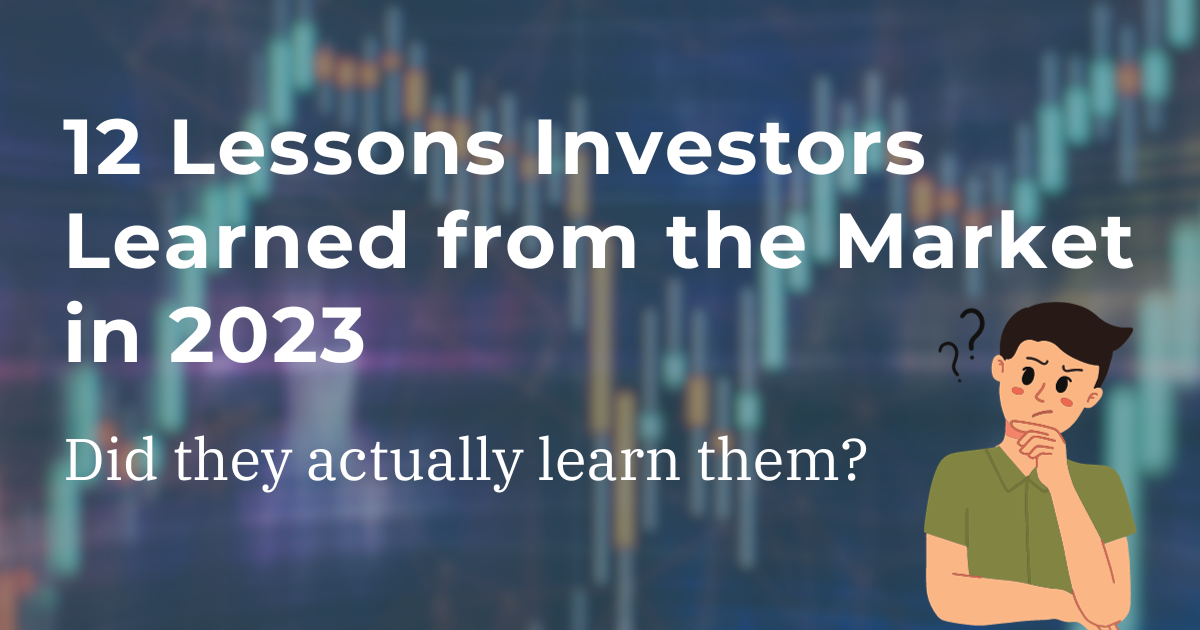I read an article like this one, “12 Lessons the Markets Taught Investors in 2023,” published by Morningstar, and a peaceful feeling comes over me: ahh, at last, investors will finally get it. I may be unique in this, but this happens to me often, usually when I read something I agree with, and which is written by a smart person. It happened to me a lot during 2020, as we dealt with COVID, the election, and everything else we want to forget about that year.
This is finally an article that investors can read and be rid of their bad investment habits. This article lists 12 lessons, and I will highlight several, but here they all are.
- Lesson 1: No One Is Very Good at Consistently Getting Market Forecasts Right
- Lesson 2: Perhaps the Magnificent Seven Should Be Called the Magnificent Three
- Lesson 3: Valuations Cannot be Used to Time Markets
- Lesson 4: It Takes Discipline to Stay the Course Through Periods of Poor Performance, as All Risk Assets Go Through Them
- Lesson 5: Assets With Poor Performance Have Self-Healing Mechanisms
- Lesson 6: Even With a Clear Crystal Ball, Markets Are Unpredictable
- Lesson 7: Don’t Let Politics Influence Investment Decisions
- Lesson 8: Most Returns Were Earned Over Short Periods
- Lesson 9: Last Year’s Winners Are Just as Likely to Be This Year’s Dogs
- Lesson 10: Active Management Is a Loser’s Game in Bull or Bear Markets
- Lesson 11: Diversification Is Always Working; Sometimes You Like the Results, and Sometimes You Don’t
- Lesson 12: Great Innovations Are Not Always Great Investments
Let’s now take a careful rant look at a few of these.
Lesson 1: No One Is Very Good at Consistently Getting Market Forecasts Right
It has been said that market forecasters exist to make weather forecasting look respectable. Still, every year, the investment houses and the talking heads on television—I heard it once called Bubblevision for all the bubbles it inflates—insist on providing their market forecasts. Some do it with humility; most don’t. Almost all get it wrong, forgetting the maxim to not mix a forecast with a date: it’s okay to say the Dow Jones Industrial Average will rise to 40,000; it’s a bad idea to say when it will happen. There is a beautiful bar chart along with this lesson in the article. It shows the dispersion between the mediate estimate and what actually happens. Why do you care what the forecasters say?
Lesson 6: Even With a Clear Crystal Ball, Markets Are Unpredictable
I’m just going to copy and paste from the article. Rewind to the end of 2022—or the beginning of 2020—and imagine knowing all that would transpire in the year ahead…
Imagine that on Jan. 1, 2023, you were provided with a crystal ball that would enable you to see the major geopolitical and economic events of the coming year. Given what happened, it’s hard to imagine that any investor would have predicted that the S&P 500 would rise 26.4%. And it is likely that many investors would have sold equities given the negative news that was coming.
The lesson is that even if you could accurately predict events, you should not try to time markets based on forecasts.
Lesson 7: Don’t Let Politics Influence Investment Decisions
This is my favorite. No matter what you tell them, investors think the decisions of President of the United States determine what happens with markets. They.Do.Not. Here’s a quote from the article:
The 2012 study, “Political Climate, Optimism, and Investment Decisions,” by Yosef Bonaparte, Alok Kumar, and Jeremy Page, showed that people’s optimism toward both the financial markets and the economy is dynamically influenced by their political affiliation and the existing political climate.
Now, imagine the nervous investor (and I have had discussions with many of them, all of whom were Republicans) who reduced their allocation to equities (or even eliminated them) based on views about the Joe Biden presidency, Democratic control of the Senate, and the exploding budget deficits (among other concerns). While investors who stayed disciplined benefited from the market’s very strong performance, those who panicked and sold not only missed out on that strong performance but persistently faced (and continue to face) the incredibly difficult task of figuring out when it would be safe to invest again. Similarly, I know of many investors with Democratic leanings who were underinvested after President Donald Trump was elected.
Is this you? Stop it! Just stop!
Lesson 8: Most Returns Were Earned Over Short Periods
If you get out of the market for even a short period of time, your long-term results could be terrible. Again, from the article… There were 1,067 months between 1927-2023. The best 97 months returned 100x (times!) the other months. Stay invested!
Lesson 9: Last Year’s Winners Are Just as Likely to Be This Year’s Dogs
Don’t chase winners. Period.
Lesson 10: Active Management Is a Loser’s Game in Bull or Bear Markets
Active management is like the proverbial broken clock that’s right twice a day. Active management’s triumphal return is always just around the corner, always waiting to shine during the next bull market.
To outperform, all an active manager had to do was overweight those big winners. On the other hand, 10 stocks lost at least 32.4% (underperforming the S&P 500 by almost 59 percentage points). To outperform, all an active manager had to do was underweight or avoid these dogs.
This wide dispersion of returns is not at all unusual. Yet, despite the opportunity, year after year in aggregate, active managers persistently fail to outperform.
There, I needed that! Now, get off my porch, you kids!
The aforesaid should not be considered investment advice, but rather the ranting of an investment guy who has seen too many mistakes made because of the unlearned lessons above.

